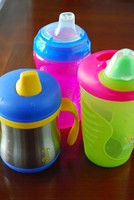Well, I’d like to be able to simply say “Happy Halloween!” and leave it at that. I love Halloween. Candy and costumes—it’s an unbeatable combination.
But I do get a sick feeling in my stomach (and not only because I ate too much of that candy) when I think of all the Halloween stuff destined for the landfill. (I can count about 20 big, plastic spiders hanging around my neighborhood right now.)
And the amount of Halloween stuff is no joke. After all, according to the National Retail Federation, Halloween is a $6.2 billion industry. And as Mother Jones’s Jaeah Lee puts it, “even in the midst of a troubling economy, Americans will spend an average of $72.31 on Halloween this year, the highest amount recorded in the last nine years.” What!? How much can that fake spider-web stuff cost?
But plastic swords that take centuries to degrade is only one scary aspect of this holiday. Mother Jones has a good run down of all that lurks in our Halloween trappings, including slave-labor candy, union-busting costumes, and lead-laden fake bling:



 Among the warning labels and safety instructions plastered all over your extensively-researched, top-dollar, highest-safety-rated, Consumer Reports-approved car seat, there is no sticker that says, “Beware! Chemicals in this seat may give your baby cancer someday.” But maybe there should be!
Among the warning labels and safety instructions plastered all over your extensively-researched, top-dollar, highest-safety-rated, Consumer Reports-approved car seat, there is no sticker that says, “Beware! Chemicals in this seat may give your baby cancer someday.” But maybe there should be! You’d think that humans would be smart enough to stop poisoning ourselves—or at least our babies. But, no.
You’d think that humans would be smart enough to stop poisoning ourselves—or at least our babies. But, no. But I’m giving it up. Really! Since my toddler started mimicking my every move, I decided that instilling in her the best possible food habits meant kicking my own worst ones. For the past two months, I’ve had a zero-sugar policy on all weekdays. (Next step: no-sugar weekends). I’ve been clean for, um, let’s see, about 43 hours and 22 minutes.
But I’m giving it up. Really! Since my toddler started mimicking my every move, I decided that instilling in her the best possible food habits meant kicking my own worst ones. For the past two months, I’ve had a zero-sugar policy on all weekdays. (Next step: no-sugar weekends). I’ve been clean for, um, let’s see, about 43 hours and 22 minutes. Oregon is looking to
Oregon is looking to 
